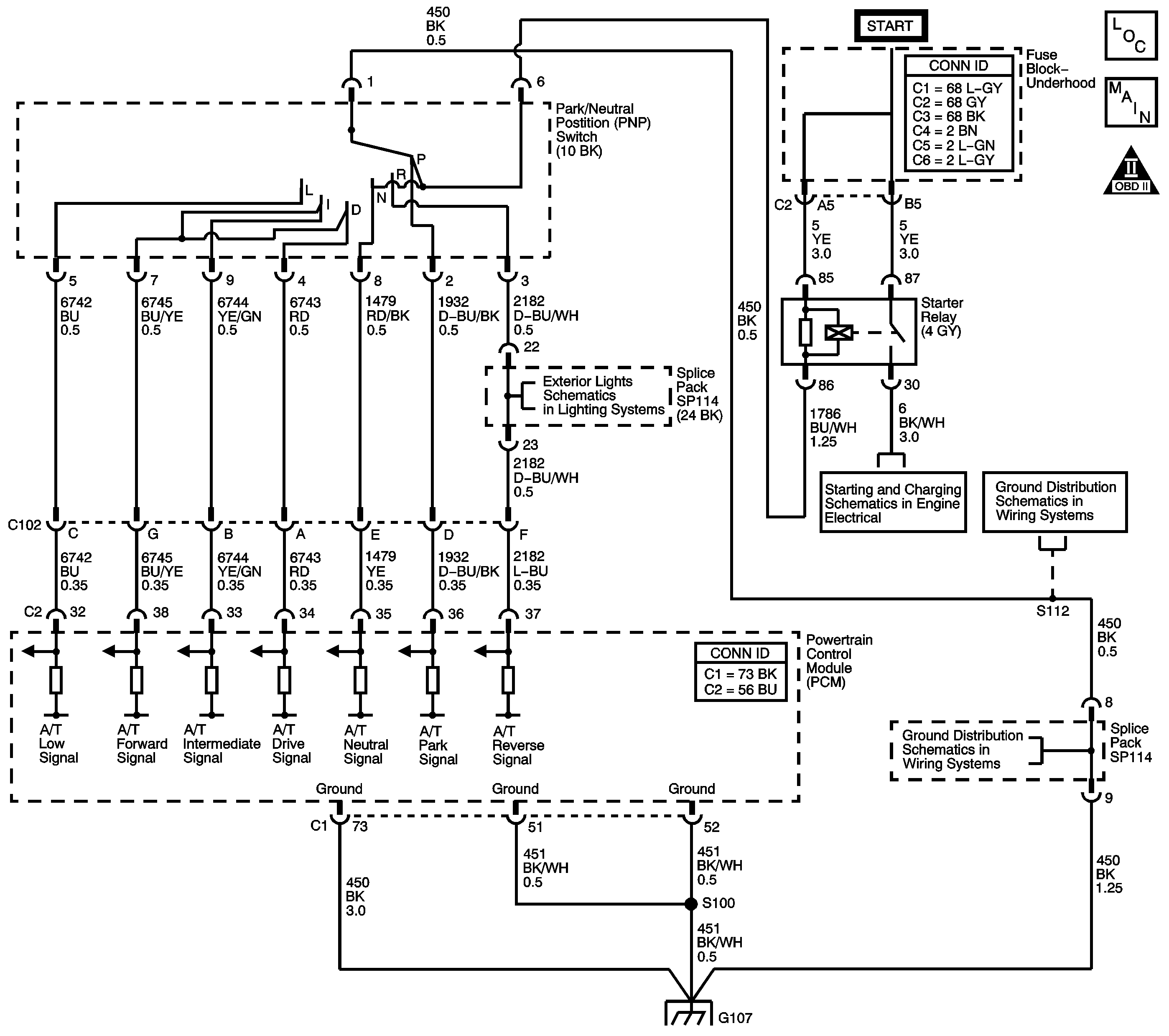
Circuit Description
The transmission range (TR) switch is part of the park/neutral position switch assembly and is mounted on the transmission manual shaft. The TR switch is a multi-signal switch. The powertrain control module (PCM) supplies ignition voltage to the TR switch on 7 signal circuits, P, R, N, D, I, L, and Forward Range. Each gear selector lever position grounds one or more of the signal circuits in a unique pattern. In order to determine the gear range selected by the driver, the PCM compares the voltage combination on the signal circuits to a TR switch combination table stored in memory. Refer to Transmission Range Switch Logic . The TR forward signal is grounded when the transmission range selector is in the D or I position. When the PCM detects that the TR forward signal is open or shorted to voltage while driving, with the transmission range selector in the D or I position, DTC P0706 sets. DTC P0706 is a type B DTC.
Refer to Range Reference .
Conditions for Running the DTC
| • | No VSS DTCs P0501 or P0502. |
| • | No TR Switch Circuit DTC P0705. |
| • | System voltage is greater than 11 volts. |
Conditions for Setting the DTC
The forward signal circuit is high during a driving cycle. The vehicle, during this driving cycle, accelerates from less than 9 km/h (6 mph) to more than 48 km/h (30 mph) and then decelerates to less than 9 km/h (6 mph) while the range selector is in the D or I position.
Action Taken When the DTC Sets
| • | The PCM illuminates the malfunction indicator lamp (MIL) during the second consecutive trip in which the Conditions for Setting the DTC are met. |
| • | The PCM records the operating conditions when the Conditions for Setting the DTC are met. The PCM stores this information as Freeze Frame and Failure Records. |
| • | The PCM stores DTC P0706 in PCM history. |
Conditions for Clearing the MIL/DTC
| • | The PCM turns OFF the MIL during the third consecutive trip in which the diagnostic test runs and passes. |
| • | A scan tool can clear the MIL/DTC. |
| • | The PCM clears the DTC from PCM history if the vehicle completes 40 warm-up cycles without an emission related diagnostic fault occurring. |
| • | The PCM cancels the DTC default actions when the ignition switch is OFF long enough in order to power down the PCM. |
Diagnostic Aids
| • | Inspect the connectors at the PCM, the output speed sensor, and all other circuit connecting points for an intermittent condition. Refer to Testing for Intermittent Conditions and Poor Connections in Wiring Systems. |
| • | Inspect the circuit wiring for an intermittent condition. Refer to Testing for Electrical Intermittents in Wiring Systems. |
| • | Inspect for a disconnected TR switch connector. |
| • | Inspect for an open FWD switch wire. |
| • | Inspect for a faulty TR switch. |
| • | Inspect for a shift linkage incorrectly adjusted. |
| • | Inspect for an internal fault of the PCM. |
Test Description
The numbers below refer to the step numbers on the diagnostic table.
Step | Action | Yes | No | ||||||||||||
|---|---|---|---|---|---|---|---|---|---|---|---|---|---|---|---|
1 | Did you perform the Diagnostic System Check - Engine Controls? | Go to Step 2 | Go to Diagnostic System Check - Engine Controls in Engine Controls - 3.5L (L66) | ||||||||||||
2 |
Does the TR Sw. Forward Range parameter remain LOW in D and I ranges? | Go to Intermittent Conditions in Engine Controls - 3.5L (L66) | Go to Step 3 | ||||||||||||
3 |
Did you find and correct a condition? | Go to Step 9 | Go to Step 4 | ||||||||||||
When the TR switch forward signal circuit is grounded, does the TR Sw. Forward Range parameter indicate LOW? | Go to Step 6 | Go to Step 5 | |||||||||||||
5 | Test the TR switch forward signal circuit for an open or short to voltage. Refer to Testing for Continuity and Wiring Repairs in Wiring Systems. Did you find and correct the condition? | Go to Step 9 | Go to Step 8 | ||||||||||||
6 | Test the TR switch ground circuit for an open. Refer to Testing for Continuity and Wiring Repairs in Wiring Systems. Did you find and correct the condition? | Go to Step 9 | Go to Step 7 | ||||||||||||
7 | Replace the TR switch. The TR switch is part of the park/neutral position switch. Refer to Park/Neutral Position Switch Replacement . Did you complete the replacement? | Go to Step 9 | -- | ||||||||||||
8 |
Important: Always perform the PCM set up procedure.
Did you complete the replacement? | Go to Step 9 | -- | ||||||||||||
9 | Perform the following procedure in order to verify the repair:
Has the test run and passed? | Go to Step 10 | Go to Step 2 | ||||||||||||
10 | With the scan tool, observe the stored information, capture info and DTC info. Does the scan tool display any DTCs that you have not diagnosed? | Go to Diagnostic Trouble Code (DTC) Types in Engine Controls - 3.5L (L66) | System OK |
